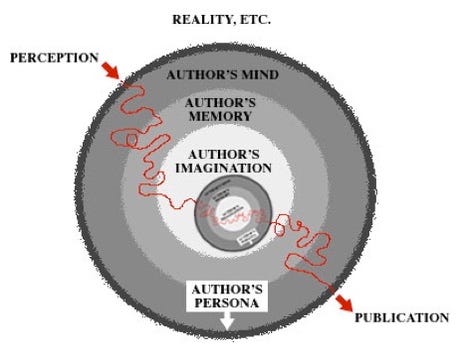Self and Alter Ego
Author and Character
. . . he found that he sounded exactly like Bertram W. Beath on the first try, and his, or their, reviews were a success from the start. Matthew has been reviewing as B. W. Beath for a couple of years now. He thinks of his alter ego as “BW,” what BW’s friends would call him if he were able to have friends, which he can’t, because he must remain concealed. When Matthew’s out doing a review, he’s disguised as B. W. Beath, the well-known restaurant reviewer, almost a celebrity, who, because he must not be recognized as a celebrated restaurant reviewer, is disguised as Matthew Barber, a nearly anonymous man, a stand-in, a shell who lends BW a pseudonym to use when he makes his reservations, who is disguised as BW, and so on, round and round in a circuit of disguise, each self concealing another, each hiding within another.
Reservations Recommended, Chapter 1
Below is a schematic diagram prepared by Kraft to illustrate the origin of a character and the location of a character within an author’s mind. The smaller entity within the author’s imagination is a character. It might be Matthew Barber. If you then picture Matthew’s self as a diagram like the main one, with a smaller entity within it, that smaller entity might be B. W. Beath.
Assume for the moment that the gentleman in the bowler hat in Fig. 4 insists that he is the sole reality, while everything else appears only in his imagination. However, he cannot deny that his imaginary universe is populated with apparitions that are not unlike himself. Hence he has to grant them the privilege that they themselves may insist that they are the sole reality and everything else is only a concoction of their imaginations. On the other hand, they cannot deny that their fantasies are populated by apparitions that are not unlike themselves, one of which may be he, the gentleman with the bowler hat.

See also: Author as God or Magician or Puppeteer TG 17, TG 94, TG 117; Character as Uncontrollable Creation TG 117
Have you missed an episode or two or several?
You can begin reading at the beginning or you can catch up by visiting the archive or consulting the index to the Topical Guide.
You can listen to the episodes on the Personal History podcast. Begin at the beginning or scroll through the episodes to find what you’ve missed.
You can ensure that you never miss a future issue by getting a free subscription. (You can help support the work by choosing a paid subscription instead.)
At Apple Books you can download free eBooks of Little Follies and Herb ’n’ Lorna.
You’ll find overviews of the entire work in An Introduction to The Personal History, Adventures, Experiences & Observations of Peter Leroy (a pdf document) and at Encyclopedia.com.



